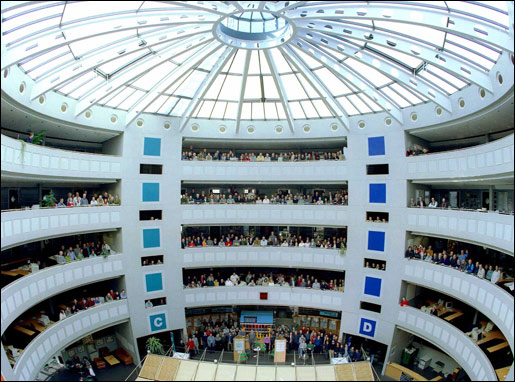
ATLAS e-News
23 February 2011
Collaborating in ATLAS: what makes it work - an outsider perspective
17 March 2008

The ATLAS Collaboration
More than 2200 scientists working on ATLAS, scattered all over the world in 37 countries – a unique feature that makes ATLAS one of the largest collaborative effort ever attempted in high energy physics. In such a huge and international experiment, how are technical decisions taken and personnel organized? Philipp Tuertscher, a researcher at the Institute of Entrepreneurship and Innovation at the Vienna University of Economics and Business Administration, is investigating the depths of the ATLAS collaboration.
When asked about the conclusions of his research, the first thing Philipp says is: “The way the ATLAS collaboration is self-organized and manages itself is fascinating.” The structure of the ATLAS collaboration, he adds, is something that a lot of people in industry just cannot believe.
What makes the collaboration so special? The answer is that, at a number of levels, ATLAS is organized in a completely different manner from traditional R&D projects: “The same challenges that big R&D projects in the corporate world face also need to be solved in ATLAS, but in a different context”
The first unique aspect of ATLAS is how the decision-making process takes place. In industry, the key decisions on how to overcome bottlenecks in a project are usually taken by management – what economists call a top-down organisation. But within the ATLAS collaboration, everybody has their say: undergraduate and PhD students, postdocs and project leaders, all voice opinions that can turn into solutions to the difficulties encountered during the project.
To understand how ATLAS works, Philipp is using a number of research methods, including interviewing ATLAS scientists, analyzing paper and electronic archives, and attending meetings and seminars. He has even studied co-authorship and topics of ATLAS Notes over the past 15 years. His findings suggest that the democratic approach of ATLAS, which encourages participation from each and every collaborator, reflects the nature of the experiment itself: “The scientific complexity of the project leads to a high degree of uncertainty and this requires creative solutions coming from all levels,” Philipp says. So, any contribution to improve the design of the ATLAS detector is not only welcomed, but is actually needed.
The difficulties in planning the ATLAS detector in advance are linked to the extremely novel technologies involved in the project which are full of surprises. This means that a priori the right path to follow is not always clear. Therefore, ATLAS scientists and engineers have developed a high tolerance to working in a very uncertain environment. “Probably the high tolerance of people is one of the reasons why the ATLAS collaboration works,” Philipp says. “For many working in industry, it would be a nightmare if they did not have clear guidance about what to do; they are striving for certainty.”
In spite of the uncertainty that surrounds any R&D project, the need to minimise strain on finances pushes those in the private sector to try to make decisions as early as possible. By way of contrast, ATLAS scientists tend to keep decisions openly throughout the project, in order to have enough time to study the different options and choose the best one. When required, scientists are even willing to revise some of the decisions taken and make adjustments to parts deviating from the baseline: “Some designs that were agreed upon in the beginning may turn out to be unfeasible or not appropriate so it may be required to change parts of the design as the project evolves,” Philipp explains. In ATLAS, the success of the experiment is the driving force for all the different working groups. So, all groups need to find common solutions, even if it means more work for one group in order to help another one.
If such a situation arises in industry, the first question would be whether it is affordable. “A group’s manager has no incentives to carry out some extra work in order to help out other groups without charging the one that required the work; without getting financial rewards, this would be seen as something too expensive,” Philipp explains.
The different mentality comes from the very different final goals: private companies are designed to develop projects to be sold. On the contrary, ATLAS goal is not to generate profit, but to generate knowledge without the burden of generating financial benefits. “In science, people have different incentives and incentives are determining what we think is important, and thus how we organize things,” Philipp says. But industrial, projects are becoming increasingly more complex and many R&D organizations start to exhibit some features of a distributed organization such as in ATLAS.
“Fundamental research projects such as ATLAS bring economic benefits through the novel technologies that spin off the project,” Philipp says. Another enormous benefit is the education that ATLAS provides to hundreds of students. Nevertheless, the main objective of public research is making discoveries. In ATLAS, all scientists are after the same goal: pushing scientific knowledge always further.
